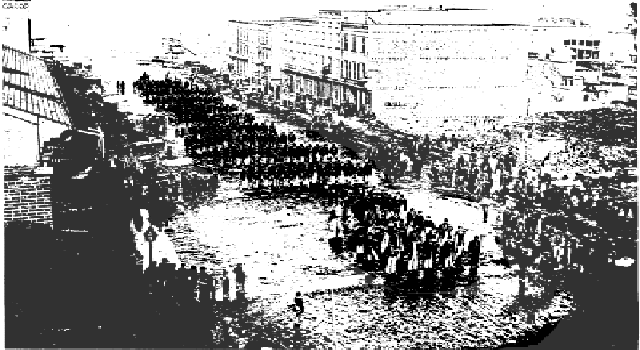
Member of "H" Company Ohio 73rd Infantry
Enlisted on 11/12/61 as Private.
On 12/30/61 he mustered into "H" Co. Ohio 73rd Infantry and was killed on
8/30/62 at 2nd Bull Run, Virginia.
Source: Official Roster of the Soldiers of the State of Ohio.
For Civil War Story on his death click here.


73rd at Chillicothe while on Veterans furlough.
History
On the 6th of October, 1861, Governor Dennision authorized Orland Smith to raise a
regiment, when completed, he should command. Camp Logan, near Chillicothe, was selected as
the place of rendezvous. The majority of the men composing were recruited in Ross County,
though parts of several companies came from the counties of Pike, Highland, Pickaway,
Athens, and Hocking. On the 30th of December the regiment was mustered into the service.
The 73rd remained in camp until the 24th of January, 1862, when they moved to
Fetterman, West Virginia, and then to New Creek. On the 6th of February it formed a part
of an expedition against Rommey. The regiment march, a few days later, on a similar
expedition against Moorefield, and at that place had its first experience of fighting.
On the 7th of May the Rebels, under Stonewall Jackson, attacked General Milroy's
advance forces at the Shenandoah Mountains, driving them back to McDowell. On the next day
a spirited engagement occurred at McDowell in which the 73rd was engage and met with
slight loss.
An Ohio Brigade was formed consisting of the 25th, 55th, 73rd, and 75th regiments under
the command of Colonel McLean. The 73rd reached the Manassas battlefield on the evening of
August 27th. On the 30th the regiment was held in reserve until the afternoon, when the
brigade was ordered to occupy Bald Hill, the extreme left of the line. The Rebels having
pressed back General Pope's right and center, came sweeping down upon the front and flank
of the left wing. At this juncture the conduct of the 73rd and its brigade help save the
army from its destruction. Its firm stand and desperate fighting enable General Pope to
rally his broken lines. The lost of the regiment was very severe. Out of 310 men present
for duty, 144 were killed or wounded and 20 capture.
Note: Above Battle also known as 2nd Battle of Bull Run.
Nothing noteworthy occurred until June 12th, 1863, when the army entered upon the
Gettysburg Campaign. It reached the battlefield in the afternoon just as the broken
remands of the First Corps and the remaining brigades of the Eleventh came steaming back
in disorder. Immediately the command was deployed upon Cemetery Hill to check the Rebels
and to cover the retreat. The bold front which the brigade assumed and its promptness in
checking the Rebel pursuit aided by the now approaching darkness, which concealed it
numbers, deceived the Rebels who supposed a fresh corps had arrived. Displayed into one
great picket line this little band of four regiments stood around the hill until midnight.
Until the end of the battle the regiment, with its brigade, held the line in front of
Cemetery Hill and was incessantly engaged on the ground to its front. The 73rd losses
during the fight amounted to 143 men out of about 300.
The 73rd was transfered on September 24th as part of General Hooker's command in the
Army of the Cumberland. The regiment reached Bridgeport, Alamaba and remained there until
October 24th when it moved to the relief of Chattanooga. Durning the night of October 28th
the Rebels recrossed Lookout Creek, occupied the hills between Wauhatchie and the main
body of the army, and made a furious attack upon General Geary. Colonel Smith's brigade
was ordered to charge the most important part of the hills on which the Rebels was posted.
Supposing the Rebel's forces to be small, Colonel Smith placed the 73rd and part of the
33rd Massachusetts (less than 500 muskets) in line, and directed them to move up the
slope. As the little column approached the summit it was saluted by a terrible fire of
musketry from what afterward proved to be an entire brigade of Longstreet's Corps, over
2,000 strong, and covered by brestworks. The two regiments fixed bayonets, and climbing to
the top, drove the Rebels out of their trenches and down the opposite slope in great
confusion. The conduct of the 73rd and the 33rd on this occasion call forth high praises
and General Grant, in his offical dispatches named it "one of the most daring feats
of arms of the war". In this action the 73rd lost 65 men.
After the regiment came back from veteran furlough it participated in the Atlanta
Campaign and two companies of the 73rd were the first troops to enter the city. Thus this
long and terrible campaign was ended. Out of 120 days of campaigning, the regiment had
been under fire for 103 days. It had lost 210 men and 8 officers out of less than 350. It
had been repeatedly engage with the Rebels and had never retreated before him.
The regiment participated in the "March to the Sea" and transverse the state
without fireing a shot. The 73rd then entered into the Carolina Campaign, January 2, 1865.
The regiment participated in the last two battles of the war, one at Averysboro and the
other at Bentonville.
The history and character of the 73rd may be summed up briefly. It served three years
and eight months, and was always in active service. It marched several thousand miles,
participated in twenty battles, not to speak of skirmishes and minor affairs. On three
occasions, in connection with its brigade, its behavior in battle decided the fortunes of
the day. Its conduct was frequently commended in general orders, and never reproach
On the 20th of July, 1865, the rolls of the 73rd were ready, and on that day the
regiment was mustered out of the service.
Ohio in the War Vol.2
by
Whitelaw Reid

Updated: April 04, 1999
Comments to webmaster